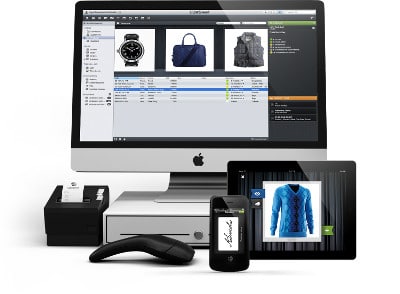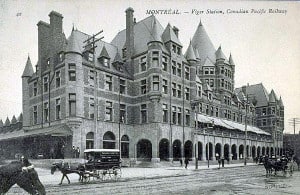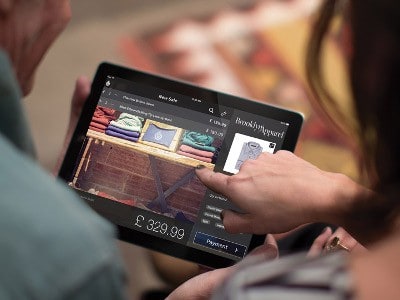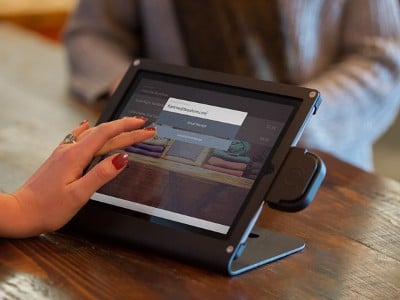

It’s difficult to remember now what life was like before the smartphone, and it will be practically impossible to talk to anyone about life without a mobile interface 10 years from now without sounding like you’ve either just been released from a 30-year prison sentence and are having difficulty adjusting to life in the modern world or have recently been unthawed after a century trapped in a glacier.
Over the past five years, the speed of change in the retail sector has been breathtaking and has seen the shuttering of several large legacy chain retailers, as well as mom-and-pop stores, who have been unable to compete in the age of Amazon and Apple.
That may be why LightSpeed Retail, founded by Dax Dasilva in 2005, already feels like a veteran, powering the back end transaction processes for small-to-medium retailers in a way that’s tailor-made for the new reality of mobile e-commerce.
Before talking business, though, I had to get some real estate anxiety off my chest. The Gare Viger, one of Montreal’s most beautiful grand hotel edifices, is a magnificent structure bordering Old Montreal and downtown, which has mainly sat empty for decades after the city’s business core shifted a few blocks northeast after the 1930s. I never fail to admire it when I’m in the neighbourhood and have long wondered about its future.
Secretly, I thought that if I suddenly became a billionaire, I could just buy the place and live in it, wandering the halls, like Charles Foster Kane, mumbling about my childhood sled.
Recently, while riding past the building as I’d done countless times before, I suddenly saw a banner announcing a new development. I immediately wondered what was happening with this architectural marvel and prayed that it wouldn’t become condos.
Later that day, an article in La Presse confirmed the building’s imminent transformation, and furthermore that LightSpeed Retail was to be the primary occupant. I decided that now was a good time to reach out to Dax Dasilva and chat about his company’s past, as well as its future, and furthermore to ask, how lucky do you feel to be moving in to the coolest old building in Montreal?
Dax: There are so many Montrealers who have the exact same story, including myself. I’m like, “What is happening with this building? Why has it been empty for so long? Why can’t anybody do anything with it?” So we’re so excited that we’re going to be the anchor tenant, taking up four suites at the very top. We’re split across buildings now. I bought a building three years ago that I thought was going to last us a very long time. It lasted us not very long at all. So, we’re split across two buildings in Mile End. We’re about 200 people globally, but 140 in Montreal. And so we’ll be able to move the whole team back together again in one place, and be able to hire a lot more people and have lots of room to grow. So, it’s exciting.

Cantech: That’s wonderful. Not to mention, they’ll be able to go down to that cool workplace. It’s like Commissioner Gordon’s headquarters in Batman or something.
Dax: The cool thing about this is that it’s actually more amazing inside than it is on the outside, even. If you can imagine, all the turrets and towers and arches, the shapes they create and the areas they create on the inside are just magical.
Cantech: That’s amazing.
Dax: Yeah, we’re excited to do tours of it when we move in.
Cantech: I think I’m going to be asking for one, if you don’t mind.
Dax: I think it’s going to be, in North America, one of the most special tech headquarters. It’s heritage, plus high-tech. It’s going to be really unique. I don’t know many other buildings that have that kind of heritage.
Cantech: Your company has been quite a growth story. You founded LightSpeed Retail in 2005. The retail landscape at that time, there were no smartphones around, it was a different kind of a time. So what kind of conversations were you having with small to medium size retailers around what was becoming a new landscape for retail? It’s obviously changed dramatically since then.
Dax: Yes, the conversations have shifted now, I think. In 2005, this is when Apple was having its big comeback. It was at the beginning of its big comeback. It was a little bit before the iPhone, but the iPod had gotten everybody’s attention, and with the iMac, Apple was coming back strong. And essentially, people were rediscovering Apple. And what was happening was that people were opening boutiques and stores, and they already loved their MacBooks and their iPods and they felt so in control of those devices that people were starting to ask the question, “Can I run my business on a Mac? Can I take control of my own small business?” And that was what rocketed us, with 1,900% growth over five years, it started on that base platform of the Mac, multi-store and multi-user for Mac. So more serious retail. But then on the Mac platform, we were the first to add mobile and worked pretty closely with Apple to make sure that the mobile solution we had in their stores was available to all SME retailers via LightSpeed. And then we brought out an iPad version in 2011. So that was very closely tracked to Apple’s growth curve. So I guess what happened after 2012, after we took our investment from Silicon Valley, $30 million from Accel, is the broader transformation in retail began to really happen, which was in order for retailers to compete against big box and e-commerce, they were going to have to reinvent the way they did business. And they had to have systems, whether it was e-commerce systems, in-store systems, tablet systems, mobile systems that all centred around the customer and customer information. And now we’re all connected into the cloud, where all the customer information, transaction information, payment information live. So we were well positioned to get a lot of that transformation happening using Apple devices and i-devices, etc. So that was the second stage of our growth, was capturing this transformation that retail was doing, which is being not afraid of e-commerce but which incorporates the best of e-commerce and integrating e-commerce for mobile, as well as tablet.
Cantech: You had a very close working relationship with Apple.
Dax: I worked in the Apple ecosystem a lot. I worked for dealerships. Before there were Apple stores, there were Apple dealerships. And then when I was 13, I was an apprentice with an Apple developer. I got my first Mac at 12. My dad was a graphic designer and he brought a Mac into our home early. So I’ve always worked with Apple developers or Apple dealerships.
Cantech: But how did that work? Were you partnering with them, developing their back-end retail systems? How did you transition that to offering it to other merchants?
Dax: In about 2009, Apple rolled out mobile check-out in their stores. It was very new. And there was a lot of demand for it from other retailers. Now, Apple systems can’t scale down for regular retailers. It was a very custom system for Apple. So we worked with them to make sure that we brought that hardware, the Linea Pro, which was like an iPod Touch with a scanner and a card-swipe, to bring that to LightSpeed so that we could offer that to clothing stores, to bike stores, toy stores, all sorts of retail. So essentially what our mission became was to bring the Apple store experience to all of retail. So that’s where we worked with Apple. We did a lot of presentations in Apple stores, so that the Apple platform would become more popularized as a platform for retail.
Cantech: I noticed that LightSpeed Retail was powering the kiosks at the Cabinet Éphémère at C2MTL. I didn’t know that when I was looking at them. I was looking at these clean, sleek terminals, but I didn’t know it was LightSpeed Retail until after the fact. What was that experience like?
Dax: That was really exciting. We also did a workshop there. We had lots of different people there from large retail to small retail. There are so many thought leaders and innovators that go to that conference and a lot of them are in e-commerce, so it was nice to be able to point to all of the Montreal boutiques running on LightSpeed at the show. The workshop we did, it was called “Building Products for Modern Retail”. What are the challenges that modern retailers have? How do you build products to help them thrive? That was kind of the theme. It’s kind of a perfect venue for us because C2MTL stands for commerce plus creativity. Retailers have to get creative and approach commerce from an omni-channel approach. You’ve got some of the best e-commerce players, like Frank & Oak, opening stores, and they’re using LightSpeed. So there is a magic to a store, and I think a store and a website can work really well together, but you have to have one system than can bring it all together. So that was part of the message. That conference is perfect, because we get to talk about that type of thinking around commerce.
The new reality is the ultra-informed, ultra-powerful consumer, a consumer that has information about products, availability, and price comparisons at their fingertips with their smartphones.
Cantech: We’ve seen a few brick-and-mortar retailers not exactly handling new phenomena, like showrooming, and the new reality of digital retail. But there are some, on the other hand, who’ve actually handled it quite well. I’m thinking of Canadian Tire, a retailer who you wouldn’t really think was particularly cutting edge or innovative, and yet it’s taken up a space in the Communitech Hub and they’re doing interesting things, and are generally a good example of a legacy brick-and-mortar retail company handling the new reality really well, whereas Future Shop and Sears are basically disappearing. What would be your primary message for retailers who are struggling right now with how things are going?
Dax: I think that no matter what system you’re going to use, no matter what strategy you’re going to take tactically, the way you have to think strategically, and of course it’s really easy to say this, but the new reality is the ultra-informed, ultra-powerful consumer, a consumer that has information about products, availability, and price comparisons at their fingertips with their smartphones. But at the same time, you can really reach those same consumers in multiple ways. So yes, you have to compete with lots of noise, but you’re also able to reach that customer in meaningful ways. And they have to be meaningful through many different touchpoints, online, in the store, etc. And in order for communication to be meaningful, they have to be rich with information. Let’s say if you’re walking into a store, and if you know more about the products than the salespeople because they’re not equipped with, for example, LightSpeed for iPad that surfaces all the information, allows the sales rep to be a genius about everything on Day 1. Unless you give your people the right tools, then you’re not going to impress your customer, let alone delight your customer, let alone make them want to come back, let alone become their destination store to go to. At the Apple store, everybody can buy those products online, but you have packed Apple stores, because the experience is memorable, because the people are equipped with technology. But at the end of the day, you don’t go into an Apple store and do a self-checkout, although you can at this point. You go in because it’s going to be efficient, because the people are going to be informed, because the brand is experienced best in 3D and because you just enjoy the environment. And that’s why some retailers thrive and do well and others don’t, because the ones that do well are centering all of their systems and crafting their experiences around those consumers, and they’re making it so good that it is entertainment. Shopping, to some degree, is entertainment. But it’s also a chance to really impress upon consumers the joy of your brand and the excitement of your brand and the greatness of the people that are working for the brand, etc. And of course, the products, to show them and to be able to really touch and feel them in 3D in the store. So there are all these things that retailers can work with, with great systems and having the right products, and having the right people, and having the right technology. But if you just stack things on a shelf and hope for the best, and hope the discounts are going to help you compete against Amazon, well, guess what? They’re not going to help you compete against Amazon.
Cantech: It probably also helps if employees feel like they have a stake in actually working there. The concept of showrooming makes sense when you walk into a place where the feeling is palpable that the employees are just kind of there, essentially just to point you in the direction of something. And then you can just go home and buy something off the internet, without having to actually deal with them.
Dax: Totally, yeah. It’s like “webrooming”. It’s another term that came up this last holiday season. It’s the phenomenon where people spend a lot of time online, researching products, and they spend not much time in the store, but they come into the store well informed and are buying more in the store. There have been some really interesting studies and statistics showing that people are using e-commerce in a reverse way, too. It’s not just going into a store, check things out, then buy it online. It’s research stuff online, finding stores where you trust the curation of the products, then going into the store and buying much more, but maybe you don’t have to be spending an hour. You can pretty much get everything you researched in about 10 or 15 minutes. So webrooming is a very positive trend for retail, and it’s yet another opportunity. If that is what consumers are doing, it’s another opportunity that, when they’re in the store, that they are wowed by the experience. Then your store becomes a destination.
The key to retail is having the right product for the right customer at the right time. The more tools and the more insights you can have supplied by the system, the more you can get that formula correct, the more customer information and history you can build.
Cantech: Yeah, I think that’s key to the retail experience, is that people feel like they want to actually go, as opposed to just stepping into some warehouse or something with underpaid employees who have no stake in being there. You’ve been taken up in the United States by DASH, which I believe is run by the Kardashians. What drove them to select LightSpeed?
Dax: Yeah, the Kardashians have three stores. They’re in L.A., Miami and New York, and I think they have plans to open multiple new stores per year. And so they’re really going to be expanding their footprint. I think what they wanted to do was to select a system that was going to easily allow them to do multiple new stores. And so that was LightSpeed Cloud, which is fantastic for managing a chain and seeing all your information and all your customers across a chain, and allowed them to do that really well. I think some of the other things that tipped them towards LightSpeed are, we brought out a new iPad client and they were a beta customer for it, which allows you to completely brand the application. And it’s sort of a tool that the sales rep uses. Of course, you can run a sale, swipe a card, have a customer sign on screen, it can do all of those things. But the sales reps, they call them “Dash Dolls”, it allows them to be a personal stylist, because it has inventory information on there, it has up-sell opportunities, like ”This dress might go with this necklace,” it allows them to show items that are coming in. So it’s a tool that helps the sales rep know more and be informed, and also allows them to look great. And of course, it’s fully branded DASH branding, so it looks like they produced the app. Which is exactly what we want. We don’t want LightSpeed all over the iPad, we want DASH. So I think that’s a big one. We just launched Advanced Reporting, which will really allow stores to get some real insights across their chain. We just launched that today, but DASH has had it for a little while. And that’s another big thing. Dakota (DiSanto), who’s the retail manager, she really needs to know what’s trending across different stores when she does her buying for the chain, and so on. So it’s those back-end inventory, and buying things. The key to retail is having the right product for the right customer at the right time. The more tools and the more insights you can have supplied by the system, the more you can get that formula correct, the more customer information and history you can build. The Dash Dolls can have a meaningful conversation with a customer when they come in, because they know all of the things that the customer likes and what their preferences are.
Cantech: You recently acquired MerchantOS, based in Olympia, Washington, and kind of rebranded them as LightSpeed Cloud, which is a product that’s complementary to LightSpeed Pro. Are acquisitions a strategy that you’re pursuing, looking forward?
Dax: Yeah, absolutely. As we build out the LightSpeed platform, there are many things that we think it would be valuable for retailers to have as add-ons. It’s not going to be possible for us to build everything. And so in some cases we can partner, and in other cases it’s important for us to have it as part of the core solution. And so we’re always looking. I think we did a really great job with bringing in a company and making it a part of the whole. I think we did that integration really well. We merged our existing Cloud team with the MerchantOS team, and everybody works great in a distributed kind of environment. So yeah, I think it’s something we definitely have an appetite for.
Cantech: You’re from Vancouver originally. What brought you to Montreal?
Dax: I moved out here with a couple of friends in the early 2000s. I think we were all just kind of excited by the allure of something that’s completely different. Montreal’s got that European sort of creative, sort of crazy vibe to it. It was pretty much the opposite of Vancouver, and as much as we love Vancouver I think we were kind of excited to spend our mid-20s somewhere a little bit more fun. And interestingly, all of my friends that moved to Montreal ended up starting businesses. So it is a very business-friendly place, too. I had friends who went to Toronto, but I think the interesting thing is that all of the Montrealers ended up being entrepreneurs. So I think there’s a very entrepreneurial spirit, and there’s a lot of government support for starting a business.
Cantech: Yeah, that’s important, too. That’s an interesting detail. The kind of myth about Toronto is that you can go there and make it in business, but you’re kind of saying that Montreal might perhaps be a better fit for that kind of thing.
Dax: I think it’s known as a creative place. I don’t think people realize how business-friendly it can be. And you can pay people well and they can live very well in this city, because it’s not expensive. So you can have people that stay with you, and that are loyal to the company and can grow with the company. There’s a lot of universities locally, and a lot of talented, creative people, so there’s a great talent pool. So I think it’s an amazing place to build a business. Before we got funding, I was actually able to buy our office building, so the real estate’s reasonable. I thought that owning the building, if anything went wrong with the company, if we ever had a sales dip, which thankfully never happened, that we actually had an asset, for example. I don’t think that’s really possible in many places, except maybe here.
Cantech: That’s true. And I guess you’re counting on the fact, also, that the people you’re hiring have chosen to live here, as opposed to just living someplace because they feel like they ought to be there.
Dax: Yeah, we have a lot of people who have come here from other parts of Canada or the U.S., but lots of local Montrealers as well, a good mix of francophone and anglophone. It has its own dynamism because it pretty much reflects the city.
Cantech: You’re flying a little under the radar, because the focus is so much on Kitchener/Waterloo and Toronto, and now a little bit Vancouver with the rise of companies like Hootsuite and whatnot. There’s been a lot of talk lately about very large privately run companies, like Hootsuite, Desire2Learn, Vidyard, Thalmic Labs, those kind of companies who began life in the start-up ecosystem, and financial types are wondering about those companies eventually IPO-ing. And I wonder what your attitude is towards the benefits of staying privately held versus seeking market money.

Dax: Yeah, I think that’s a possibility for our future, for sure, an IPO. I think that our investors are pretty focused on building value in the company. And us, too. That’s really the day-to-day focus here. When they invested, we had about 7,000 stores on the software. Today we have 18,000, two years later. So I think we’re more focused on building solutions that can get more market share and mind share, and we’re less focused on exits or the endgame. Maybe in a few years, that’ll be something we’ll start to publicly talk about, if that was necessary, to go to a level that we couldn’t achieve without going IPO. You know what I mean? At the moment, I think we’re well capitalized. There may be more fundraising in the future, but I think an IPO is probably is not something we’re strongly contemplating right now.
Cantech: Well, it’s certainly a healthier approach, compared to the dot-com bubble days of 2000, where companies were just kind of flying into IPO without so much as a business plan.
Dax: We worked for seven years without funding, you know? We went for seven years boot-strapped. So it’s very much in our culture to build something natural, something organic and real, as opposed to just inflate something that’s not really without substance and then hype it. It’s not really how we built the company.
Cantech: Sometimes I wonder about retail habits that we have today. What do you think is an aspect of retail culture that we’re going to look back on in 10 years and say, “Do you remember when we used to line up?”
Dax: Lining up has its days numbered, for sure. I think in five years, when we go into a store and we have to queue up at a counter, I think we’re going to be fairly judgemental of that retailer. As we should be, especially during the holidays. There is still a need for a cash area for lots of types of business, so maybe we won’t lose the counters entirely. But if you’re picking up a quick item, I think mobile POS will be pretty prolific within the next five years. So that’s definitely one of them. We should never be queuing up.
Cantech: I think it’ll be like a museum piece or something, to see a real live cash register. I’m looking forward to that time.
Dax: I think the other one is receipts. Mobile checkout and email receipts go, I think, hand in hand. Most new systems offer that, some better than others. But those are things that probably in the next five years will be pretty standard, so in 10 years we’ll definitely look back on that and say, “Remember when we had little pieces of paper?”
Leave a Reply
You must be logged in to post a comment.







 Share
Share Tweet
Tweet Share
Share




Comment